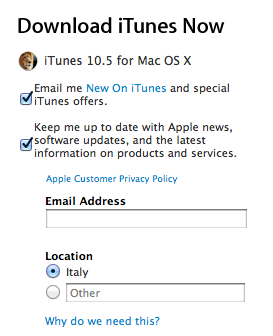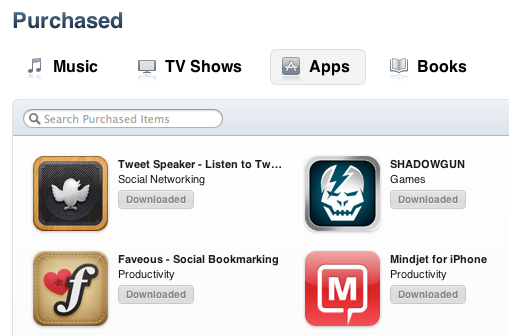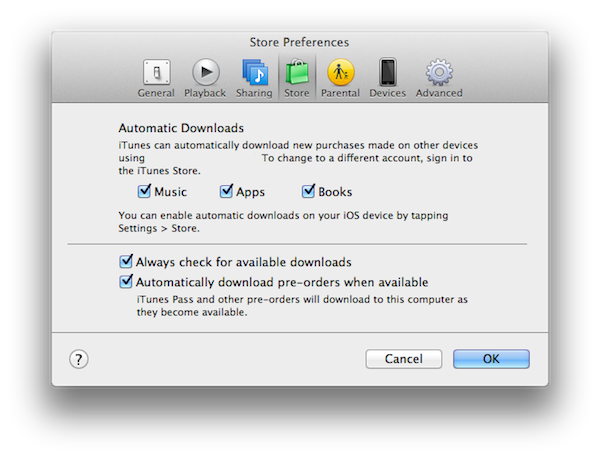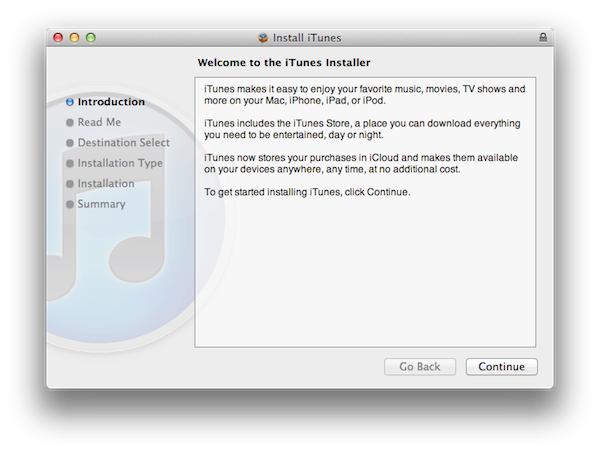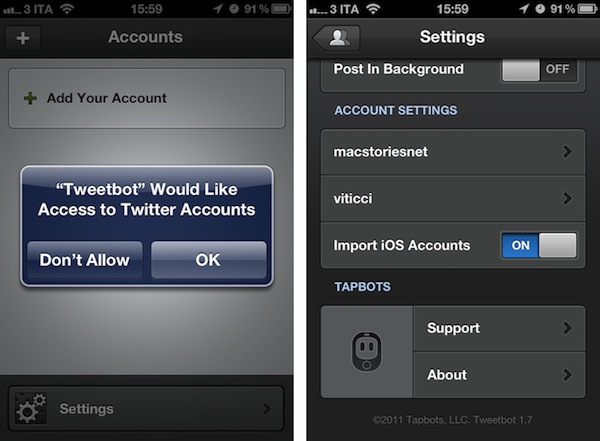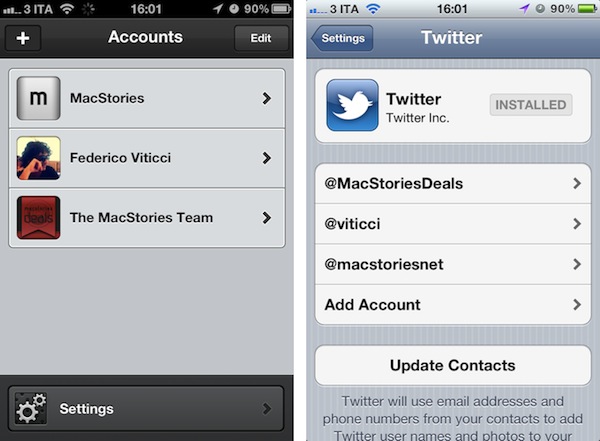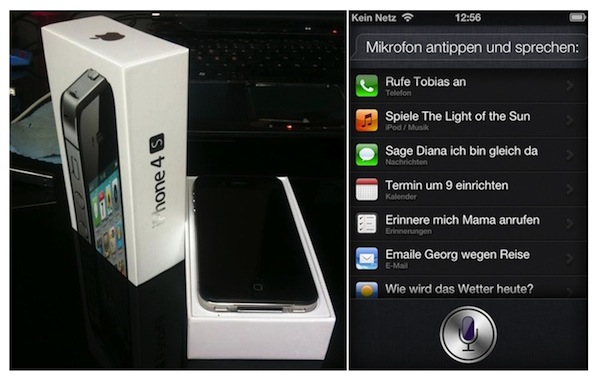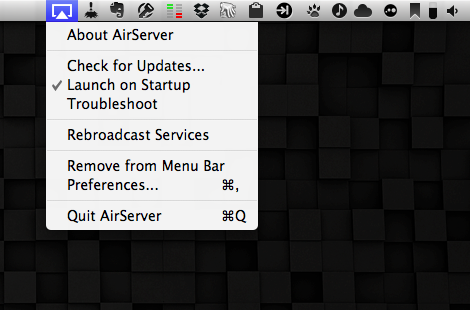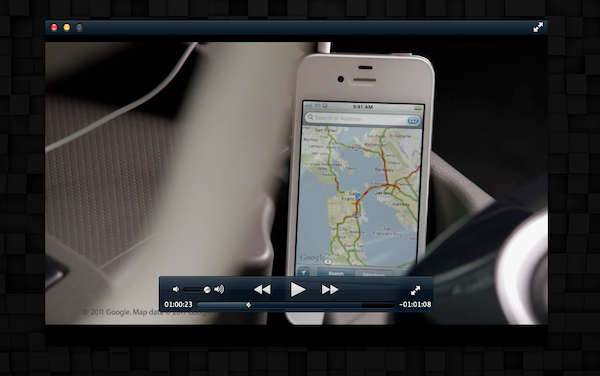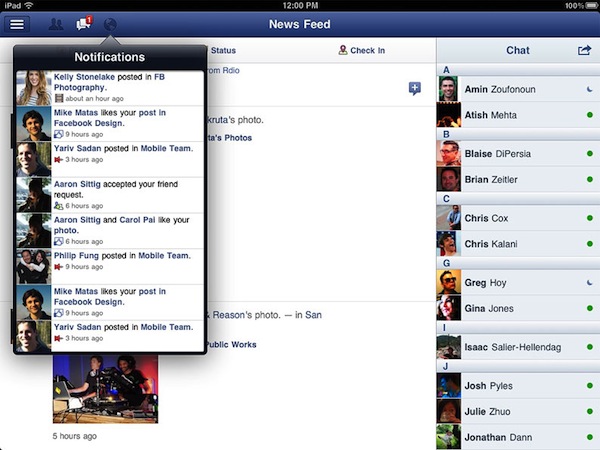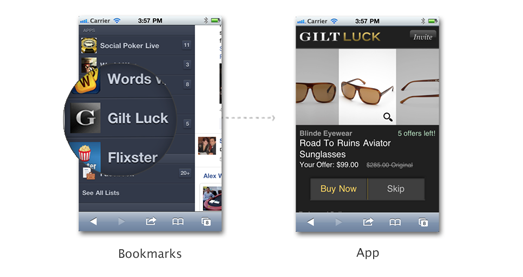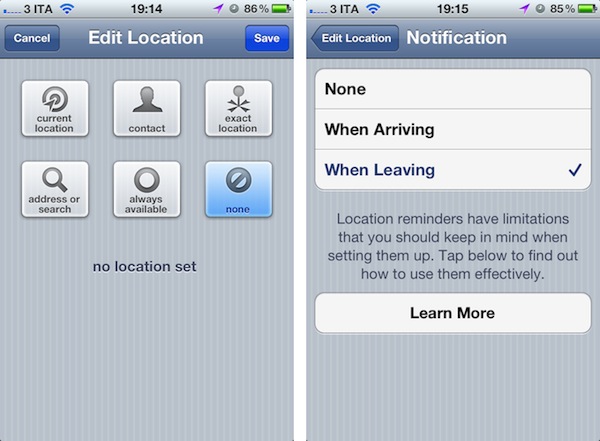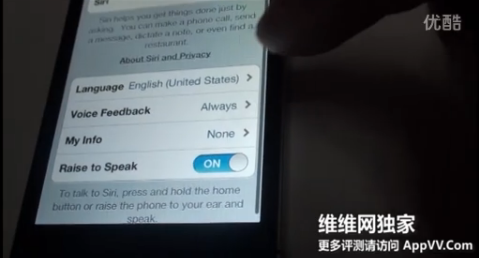Here are today’s @MacStoriesDeals on iOS, Mac, and Mac App Store apps that are on sale for a limited time, so get them before they end!
#MacStoriesDeals - Tuesday
Apple Releases iTunes 10.5
Apple today released iTunes 10.5, a new version of its media manager that adds a number of improvements and official support for devices running iOS 5. The next major version of Apple’s iOS is coming out this week on Wednesday, October 12th, and iTunes 10.5 will be required to sync devices that will be upgraded to the new software. For iOS 5 devices, iTunes 10.5 brings WiFi Syncing, a new feature that will allow owners of an iPhone, iPad or iPod touch to sync apps and media wirelessly through iTunes.
iTunes 10.5 was originally seeded to developers in June, when Apple also released the first beta version of iOS 5. Since then, we noted iTunes 10.5 included some minor graphical updates to the interface; this summer Apple also rewrote iTunes’ codebase to take advantage of Lion with full 64-bit support, and this new version of the app includes the changes we originally reported here. iTunes 10.5 also adds support for iCloud, Apple’s new cloud service that allows users to store digital purchases in the cloud, and re-download them at any time on any device. This functionality was previously activated as “beta” and called iTunes in the Cloud; as Apple notes, “iTunes in the Cloud is now part of iCloud”, but that doesn’t change the way songs and apps have been able to be pushed across devices since last June. iCloud will also be officially launched on October 12th alongside iOS 5.
As we detailed in June with the release of “iTunes in the Cloud” as beta for iOS 4.3 and iTunes 10.3, iCloud support in iTunes allows users to re-download all previously purchased songs, TV shows, apps and books at no additional charge. In the new Purchased section of iTunes, users will find a link to browse previous downloads and re-download them at any time. Another option to automatically fetch all new downloads from any device and save them on a Mac or PC – called Automatic Downloads – is also enabled with iCloud on iTunes 10.5.
The ‘Purchased’ screen is a really handy feature to easily and quickly find a previous purchase and instantly download it or even download all of your previous purchases with just one click. The feature, which is also included in iOS 5, is part of Apple’s iCloud, which was unveiled at yesterday’s WWDC keynote. The ‘Purchased’ screen also gives you some fairly powerful tools to find the exact purchase you want, either from just searching, only displaying items not downloaded to your iTunes library or just list the purchases alphabetically.
You can download iTunes 10.5 from Apple’s website, or directly on your Mac through Software Update.
Update: Full changelog of iTunes 10.5 below.
What’s new in iTunes 10.5
- iTunes in the Cloud. iTunes now stores your music and TV purchases in iCloud and makes them available on your devices anywhere, any time, at no additional cost.
- Automatic Downloads. Purchase music from any device or computer and automatically download a copy to your Mac and iOS devices.
- Download Previous Purchases. Download your past music, TV, app, and book purchases again, at no additional cost. Previous purchases may be unavailable if they are no longer on the iTunes Store.
- Sync with your iPhone, iPad, or iPod touch with iOS 5.
- Wi-Fi Syncing. Automatically sync your iPhone, iPad, or iPod touch with iTunes any time they’re both on the same Wi-Fi network.
Update #2: It appears iTunes Match has been removed from this public version of iTunes 10.5 – iTunes Match is still developer-only and launching at this end of this month.
Tweetbot Gets iOS 5 Twitter Integration with Single Sign-On
iOS 5 is officially launching tomorrow, and the App Store’s review team has been busy these past few days quickly approving app updates that take advantage of the new features available to developers. A first example was OmniFocus for iOS, updated to include the location reminders Apple will make popular with its own native Reminders app. Today another popular third-party app for the iPhone, Tweetbot, has been updated to include bug fixes and a new iOS 5-only feature – Twitter integration.
Whilst we’ll have a detailed overview of Twitter integration in iOS 5 tomorrow, Apple has already announced that developers will be able to use a feature called single sign-on to let their apps fetch Twitter credentials directly from the operating system, which has a new Twitter panel inside the Settings. Thanks to single sign-on, if a Twitter account (or multiple ones) are already configured in iOS 5’s Twitter settings, third-party apps like Tweetbot won’t need to re-authenticate users through a clumsy web view as they’ve been forced to do until today. They can simply get the account-related information from iOS’ Settings app.
So when you’ll install iOS 5 tomorrow, try to add your Twitter account to the iPhone’s settings – this will enable other functionalities that we’ll also cover tomorrow in our overview. Then install the new Tweetbot 1.7, which is already available, and you’ll notice you won’t have to re-enter your Twitter credentials again – Tweetbot will ask you if it’s okay to add the accounts already on your device. The procedure takes seconds, and is managed by an “Import iOS Accounts” option in Tweetbot’s settings. The best part is that because third-party apps are deeply integrated with Twitter in iOS 5, new accounts you’ll add through Tweetbot will also be carried over the system’s Twitter settings.
This kind of Twitter integration with the OS makes for a better first launch experience as users don’t need to go find their Twitter passwords again and re-authorize every account on each Twitter-enabled app. Tweetbot is the first popular third-party client to take advantage of this, and you get it now on the App Store for $2.99.
iPhone 4S Starts Arriving to German Customers Ahead Of Launch
The iPhone 4S isn’t officially launching until Friday, October 14th, but a few lucky German customers have apparently received their shipments early, as reported by German website Macerkopf.de. The article explains an iPhone 4S pre-ordered through Deutsche Telekom arrived this morning at a customer’s house, who promptly shared photos of the packaging, device and Siri. The packaging looks fairly similar to the existing iPhone 4 box, and a screenshot shows Siri working in German – indeed, Apple has confirmed that the first beta version of its new voice assistant software will be available in English, French and German, with more languages to come in the future. More photos are available at Macerkopf.de.
This isn’t the first case of iPhone 4S photos ahead of October 14th – just yesterday we posted a video of someone showing off the iPhone 4S’ Siri settings and browser benchmarks.
Customers in the US have received shipment notifications by Apple and various carriers including Sprint, with delivery dates set to October 14th, when the iPhone 4S officially launches. Apple has announced 1 million iPhone 4S pre-orders in the first 24 hours of availability, and shipping times on the US Apple Store are now set to 1-2 weeks.
AirServer 3.0 Brings AirPlay to the Mac With Full iOS 5, Lion Support
When I first reviewed AirServer for Mac back in May, what I saw was a very simple and fairly stable utility that allowed users to transmit audio, photos and videos from an iOS device to a Mac’s screen on a local network. Since the launch of AirPlay in November 2010, a number of unofficial apps and hacks have surfaced enabling users to enjoy Apple’s streaming technology on otherwise unsupported devices: AirServer aside, we’ve seen other apps to turn iOS devices into AirPlay receivers and even popular apps for the Mac adopt AirPlay’s streaming for music.
AirServer, initially released as a simple menubar app, has always been the app that aimed at bringing “AirPlay for everything” to the Mac since its first version. Whereas similar hacks from other developers focused on turning the Mac into a receiver for photos or video, AirServer has been improving on the concept of a standalone solution for sending anything via AirPlay from iOS to OS X. The app eventually made the leap to iOS for jailbroken devices, and gained initial iOS 5 and Lion support earlier this year.
With AirServer 3.0, released yesterday, the developers have completely re-engineered AirServer to fully take advantage of iOS 5’s AirPlay and Lion compatibility. I’ve tested the app last night, and it’s already working fine on the Golden Master releases of iOS 5 and OS X 10.7.2. Once you’ve installed AirServer 3.0 as a preference pane (it’s also got a new iCloud-like icon) and assigned a name to your Mac (the one that will show up in the list of AirPlay devices on iOS), you’ll be able to send music, photos and videos to your Mac. Unlike the previous versions of the app, however, support for AirPlay streaming has been dramatically improved: music never dropped on my connection, not even once, and it’s possible to send photos and music at the same time. Thanks to iOS 5, AirServer has integrated seamless streaming transitions between photos, slideshows and videos – the app supports AirPlay slideshows from the Photos app on iOS, including animations that will be displayed on your Mac’s screen as AirPlay switches between photos. The transition between songs, photos and slideshows is smooth and much more natural than AirServer 2.
The big change in AirServer 3.0 is video streaming. With the new version the developers have replaced QuickTime Player with their own video player based off Perian, which is optimized for network streaming and multiple displays. I have tried the new AirPlay video streaming with several videos from my Camera Roll, YouTube and Safari, and it’s incredibly better than the old QuickTime-based streaming. The player looks nice, but more importantly it’s fast and loads videos coming from an iPhone or iPad much quicker than before. You can use the video player in full-screen mode, or resize its window to fill a portion of the screen.
At $7.99, AirServer is a complete solution to turn your Mac into an AirPlay receiver for music, photos and videos. Get it here.
Facebook Releases Official iPad App, New Mobile Website
After months of speculation, Facebook released today the first version of its official iPad application, available for free on the App Store. The version available today looks fairly similar to the leaked app posted by TechCrunch earlier this year: there is a navigation sidebar on the left side of the screen to search, open your Facebook profile, check out the News Feed, Messages, Events, Friends and more. An upper toolbar gives you access to friend requests, messages and notifications, whilst Chat has been integrated in a right hand vertical panel. Judging from a first test, it appears what we wrote back in July still holds true for the final Facebook iPad app:
Facebook for iPad uses a concept not too dissimilar from Twitter’s iPad app — rather than displaying all content vertically, the app heavily relies on horizontal navigation to access various Facebook sections, the news feed, chats, liked posts, and so forth. For instance, a sidebar on the left contains tabs below your main profile to open your News Feed, Messages, Events, Places, Friends, and Photos. In the same sidebar, there are links to jump to the groups you’re subscribed to — it almost appears as Facebook wants to put the focus on Groups as much as Google gave Circles, its friend-organization tool, a huge role in Google+. There are two top bars in the middle panel: one has buttons to upload photos from your iPad’s camera and library, the other two are associated with a regular status update and check-ins. In the blue toolbar, the app has a series of additional icons to open the friend requests panel, messages, and notifications — this looks very similar to Facebook on the desktop, and the design is very distant from Facebook’s implementation on the iPhone. There is also a search function in the app, though it’s been placed at the top of the sidebar, rather than the toolbar.
We’ll have a more detailed look at Facebook’s iPad client as we get to play with it in the next few hours. Another prominent feature of today’s Facebook’s releases is app discovery and integration with mobile browsers – basically what used to be called Project Spartan in the weeks leading up to the iPad app’s release. The Facebook app now allows users to tap on links shared on the News Feed by specific apps, like Words with Friends, and if the app is already installed on the device and recognized by Facebook, it’ll launch it. If the app isn’t installed but available on the App Store, Facebook will forward the link to the App Store; if no App Store version is available, Facebook will try to load a new HTML5 version as part of a partnership with several developers to bring Facebook apps to mobile browsers. Previously, many Facebook apps had to be written in Flash to run on Facebook’s website, and this limitation made them incompatible with Apple’s devices and Safari browser, which don’t support Flash. AllThingsD shares more information on this new web initiative from Facebook:
The combined native and Web app experience is only available on iOS for now. On Android and other phones with Web browsers, users will default to the Web experience. Facebook CTO Bret Taylor told AllThingsD today that Facebook is also working on an update to its native Android application.
On the downside, there’s one place Facebook wasn’t able to negotiate a consistent experience for users: payments. This was a major sticking point in ongoing discussions with Apple, as I’d written last week. Facebook Credits can’t be used to pay for virtual goods within in native iOS apps or mobile Web apps running within a Facebook app on iOS. Instead, users will have to buy separate in-app currency through Apple’s own in-app payment system.
Facebook notes that there are some missing features from its iPad client such as the ticker, a recently launched interface to access your friends’ recent activity from a sidebar on Facebook’s website. Facebook says the ticker couldn’t be implemented on the iPad due to time constraints and limited real screen estate. For this first release, Facebook is putting the focus on photos, available in high-res thanks to the iPad’s screen, games and simplified navigation, which allows you to switch between posts, friends updates and messages with a few taps through the iPad’s interface.
The new Facebook mobile interface is also live through Safari on iOS; the mobile website has received several updates detailed in this blog post, and it borrows heavily from UI elements of the iPad app released today, with a toolbar for friend requests, messages and notifications, and “bookmarks” on the left to search, open your profile, pages, News Feed, and so forth.
With the new Requests dialog for mobile, users can invite their friends to your app. Friends can receive requests anywhere that your app is supported. For example, if a user plays a move in a game on Facebook.com, their friend can respond from her iPhone. As with bookmarks, users will tap the notification and land directly on the mobile version of your app, whether it is a native iOS app or a mobile web app.
Navigation on the new mobile website has been dramatically improved with this update – switching between sections doesn’t reload the entire webpage and it makes for a faster, more pleasant mobile browsing experience. An obvious advantage of the native Facebook apps remains camera access and chat, which the mobile web version still can’t provide through Safari and other mobile browsers.
You can find Facebook for iPad here, and check out Facebook’s new mobile web view at m.facebook.com.
Update: I’ve been playing with the Facebook iPad app, and I’m fairly impressed with how the final version turned out to be – clearly, the app that leaked this summer was a development build that wasn’t ready for primetime. The News Feed design is clean and simple, but unfortunately it’s also the only section that lagged a bit in performances on my iPad 2 with iOS 5: the News Feed’s scrolling isn’t terribly smooth, certainly not as fluid as scrolling through a user’s profile, the Messages window or a Facebook page. I assume Facebook will make changes in the next few weeks to make the News Feed as smooth as possible. Another thing I didn’t particularly like is the Settings window, which isn’t iPad optimized and looks strange on the big screen.
But everything else is quite impressive in this first iPad app. You can have chat conversations with multiple contacts as you’d normally do, and keep the conversations going either by using the Chat sidebar or the unified Messages view. When a contact pings you in Chat, Facebook brings him/her at the top of the list so you can easily respond; unlike Facebook.com, chats aren’t displayed as open “tabs” along the bottom – they’re listed at the top of the Chat sidebar and you can go back and forth between them by tapping on them.
It appears Facebook has given much importance to gestures in this iPad release: you can swipe to open the left sidebar (the one that displays Search, Favorites, Apps and Pages) and swipe to navigate back to previous screens. For instance, you can open your profile from the News Feed, check out something on your profile, then swipe back to the News Feed. Animations are quite fast and responsive. Profiles’ design is extremely simple, with tabs on the left to access the Wall, Info screen, Photos and Friends. These last two items are presented with a typical iPad grid interface, and you can pinch to open photos (or swipe to navigate between them in full-screen). You can add a new friend from the Profile view or, if you’re already friends with someone, tap on the action button in the upper right corner to Send a Message, Chat, Poke and Unfriend. While on a friend’s profile, you can obviously like and comment on posts too, and the buttons to perform such actions have been moved into a single + icon next to each post.
The most visible interface elements of the new Facebook app are the sidebar and toolbar. The upper toolbar, just like Facebook’s website, contains buttons to see Friend requests, messages and notifications. While the updated Facebook mobile website had to recreate Apple’s popover menus inside Mobile Safari, Facebook for iPad features native popover menus to check out requests and notifications; Facebook developers went as far as adding popover-based interaction for posting a new status update (with options to tag friends, insert location, attach a photo or video, and control privacy settings). Popovers work nicely in offering a quick glance at what’s new in your Facebook account, and a little red badge will sit next to them for a missed notification or friend request. When you tap on a notification for someone that liked or commented on a post of yours, Facebook won’t take you to a single page for that comment thread – it’ll open a sidebar allowing you to comment back. Messages, too, when accessed from the upper toolbar won’t launch a dedicated page – they’ll enable you to reply from within the popover itself. It’s a nice touch that simplifies navigation by eliminating the need of constantly swiping through pages, and a huge advantage over the mobile website (which, as you can guess, doesn’t let you reply inside popovers like the iPad app – it’ll quickly reload a new page). Another nice addition to the Messages’ popover menu is the action button that lets you open a thread in the full Messages view, archive it, mark it as spam or unread. The main sidebar on the left, too, provides quick access to often-used Facebook sections with a few taps. Your friends, News Feed, Messages and Nearby check-ins will be listed here if you want to check them out. But the new addition in this 4.0 release is the aforementioned app discovery: apps that have been connected with your Facebook account will show up as entries in the Apps section of the sidebar. Tapping on these apps will launch them if already installed on the device, or open the App Store. Which brings me to the also-updated Facebook app for iPhone.
Facebook for iPhone has received a massive overhaul that makes the app look a bit like the iPad version and new mobile website (screenshots below). Unlike the mobile website, however, items in the top toolbar won’t open in popover menus: Facebook for iPhone loads new full-screen windows for them, and I assume it’s because popovers are native to the iPad’s SDK, not the iPhone’s. The fact that Facebook was able to implement popovers on the iPhone’s web UI clearly shows the different kind of control the web gives Facebook. However, small technical differences aside, Facebook 4.0 on the iPhone looks very similar to its web counterpart. The sidebar is the same, basic navigation concepts are the same, and apps are listed in the sidebar. And because on my iPhone I have some third-party apps that are connected to Facebook, I was able to launch them directly from the iPhone app’s new sidebar. I tapped on Instagram and Shazam, and Facebook for iPhone launched them directly. Other apps that weren’t installed forced Facebook to open the App Store link instead.
Overall, I have the feeling Facebook did something very good this time. The technologies used in the mobile website make for a better experience and unify the Facebook user interface across devices; the new iOS app is more polished, faster to navigate, and it’s got the same obvious perks like chat and camera access. The iPad app is especially easy to use thanks to gestures and the bigger screen, which makes everything more readable and “organized”. The iOS app could still use some tweaks (especially in scrolling the News Feed), but I believe version 4.0 is a huge step forward for Facebook, and the mobile interface is a platform we should keep an eye on in the next months.
Find a gallery of screenshots below.
#MacStoriesDeals - Monday
Here are today’s @MacStoriesDeals on iOS, Mac, and Mac App Store apps that are on sale for a limited time, so get them before they end!
OmniFocus Updated with iOS 5 Location Reminders
The Omni Group released two updates for its OmniFocus app for iPhone and iPad today, adding several bug fixes and improvements, iOS 5 compatibility, and a new Location Reminders feature that leverages iOS 5’s geo-fencing APIs to send you a reminder when you’re in the right area to complete an action. The same technology is used by Apple in Reminders, a new native app in iOS 5.
The new Location Reminders in OmniFocus require an iPhone 4 or iPad 2 3G with iOS 5 installed. iOS 5 isn’t coming out until Wednesday, October 12th, but I’ve been able to test the functionality on my iPhone 4 running the Golden Master release of iOS 5. In the new OmniFocus, location needs to be assigned to a Context from the context editing view. The location settings have more options than Apple’s Reminders app – you can assign a location to a context by fetching the current location via GPS, selecting a contact’s address (like Reminders), or pinpointing your exact location. You can also manually search for an address, select “always available”, or choose to skip location altogether by choosing “none”. Once you’ve set a location for a context, you can select how you should be notified for an available task: when you leave or when you arrive. In this screen, The Omni Group warns that Apple’s geo-fencing technology in the first version of iOS 5 has a series of limitations to keep in mind – opening the app’s Help screen reveals that location-based reminders might not be 100% accurate, especially if you quickly leave/re-enter a location, or quickly pass by one (example: while driving on the highway). This is something The Omni Group can’t really address on its own as it’s a set of APIs provided by Apple, and if anything it shows that the developers are committed to providing an optimal experience by offering even more location options than Apple’s Reminders. In my tests, I can confirm OmniFocus’ (and Reminders, too) location alerts haven’t been accurate all the time – current location would work with a specified area, but not a manually-entered address. Similarly, the distance settings offered by OmniFocus sometimes failed in reminding me to do something when I was leaving a location; the app offers three different dots to determine distance, a small one for about 200 meters (600 feet), a middle-sized circle for 500 meters (1500 feet) and a big circle for 10 kilometers (6 miles). Again, these are options that Apple doesn’t provide in its native Reminders app.
It’s too bad location technology for reminders in iOS 5 still needs some optimizations, because I believe OmniFocus’ support for the feature is just great. The user interface is simple and elegant, the context-based system is meaningful to the concept of context itself, and OmniFocus is still a fantastic piece of software (with several bug fixes that you can check out in iTunes’ changelog). There’s no doubt Apple will improve location reminders over time, and please note, too, that there’s a chance the functionality will work perfectly for you, and addresses in my area simply don’t want to cooperate with Apple and OmniFocus.
You can get the updated OmniFocus in the App Store here (iPhone) and here (iPad).
First iPhone 4S Hands On Video Shows Siri Settings, Early Benchmarks
The iPhone 4S will be officially launched later this week on Friday, October 14th, but it appears someone has got access to a unit early and posted a video online showing initial browser benchmarks and Siri’s preference panel in the iOS Settings app. Siri’s preferences, located in Settings -> General, contain options to set the assistant’s language (English for Australia, United Kingdom and United States, plus French and German) and two menus for “Voice Feedback” and “My Info”. The video shows that these two options can be set to “Always” and “None”, respectively. Interestingly enough, Canada isn’t included in the list of English-supported countries, raising doubts as to whether it’ll be “officially” supported in Siri when the iPhone 4S comes out this week (Canada is a launch country, and it seems like Siri recognizes different accents fairly well). Last on the list is Raise to Speak – an option that should allow users to talk to Siri by simply raising the iPhone to their ear. Alternatively, Siri can be activated by pressing and holding the Home button.
As MacRumors also notes, Sunspider benchmarks show a score of 2222.1ms and a BrowserMark score of 89567. The iPhone 4 with an A4 chip running iOS 5 is believed to score 44856 in BrowserMark, thus making the iPhone 4S from the video twice as fast as the old-generation iPhone. The iPhone 4S comes with an A5 chip for improved performances and faster graphics.
The iPhone 4S is set to come out in seven countries on Friday, October 14th, and pre-orders have topped 1 million in the first 24 hours. It’s unclear how the person in the video below got an iPhone 4S early, but it appears to be from China as the carrier’s settings show China Unicom.
Read more



